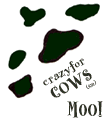|
Digestion: Cows are ruminants,
members of the suborder Ruminantia (order
Artiodactyla). Other members of this suborder are the pronghorns,
giraffes, deer, antelopes, sheep, and goats. Most ruminants have
a four-chambered stomach.
(Camels and some other ruminants, however,
have a three-chambered stomach.)
Cows and other ruminants have a very different digestive system than humans do
which work very differently in order to digest the foods they eat. The stomachs
that they have all serve different purposes in order to break down these foods
properly. Humans eat so many types of foods that our bodies cannot always break
down them correctly. This can lead to fatty build ups amongst other issues.
The
ruminants use their different stomachs in a series events so that different
protozoans and bacteria can properly breakdown the hard to digest foods.
Each phase of the ruminants' digestion helps to
provide them with valuable nutritional substances like protein.
The first chamber is the large rumen (or paunch). The next two
are the reticulum and the omasum (psalterium or manyplies). These
first three chambers are believed to be derived from the esophagus.
The last chamber is the abomasum (or reed), which corresponds to the
stomach of other mammals.
The combined four-chambered stomach is big. In the domestic ox (Bos
taurus) the whole stomach occupies nearly three-quarters of the
abdominal cavity. In medium sized cattle, the rumen by itself
can hold between 25 to 75 gallons. The rumen grows large
in early life after the changeover from a milk diet
Ruminants eat fast and store large quantities of grass or foliage
in the rumen, where it softens. Many species of minute protozoans
and bacteria live without free
oxygen in the rumen. These little animals and bacteria digest
the cellulose in the plant material, thereby releasing the contents
of the plant cells for digestion by the cow.
Large amounts of saliva get secreted into the rumen to further the
digestion.
The action of the various microbes produces various substances,
including fatty acids which are absorbed through the rumen wall.
In addition, any protein is converted into fatty acids and
ammonia; the ammonia and other simple nitrogen-containing substances
are used by the micro-organisms for their own cell-protein synthesis.
After the plant material is processed in the rumen, it is later
regurgitated. This material is now called cud, and the ruminant
chews it again. The additional chewing breaks down the cellulose
content, which is difficult to digest, even more. The
regurgitation and chewing of the cud is called rumination.
The chewed cud goes directly to the other chambers of the stomach
(the reticulum, omasum, and abomasum, in that order).
Additional digestion, with the aid of various essential
microorganisms, continues in these other chambers. For example,
in the omasum, some fatty acids and 60-70 percent of the water are
absorbed. In the abomasum gastric juice containing hydrochloric acid
is secreted, as in an ordinary mammalian stomach, futher digesting
the food. Also, those micro-organisms that used the ammonia and
other nitrogen substances from protein in the rumen, actually get
digested by the ruminant in the abomasum and small
intestine, thereby providing the cow with protein.
Source: Encyclopedia Brittanica online at http://www.brittanica.com,
entries Ruminant and Artiodactyl, digestive system.
|



